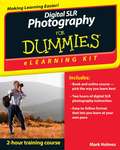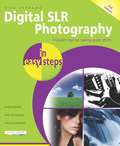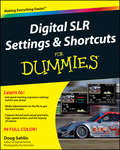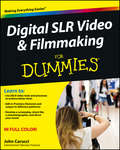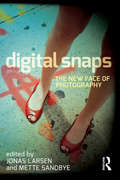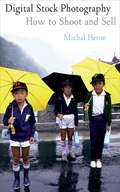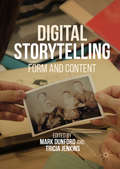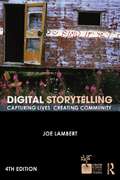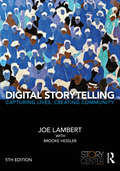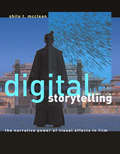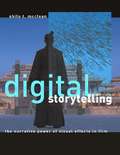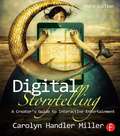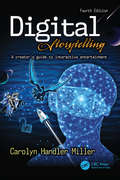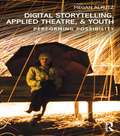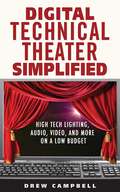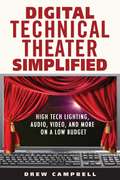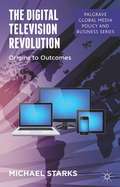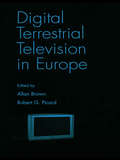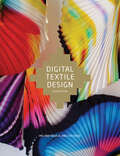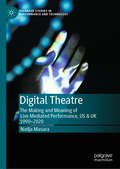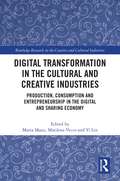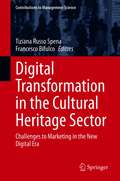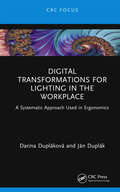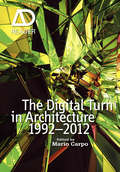- Table View
- List View
Digital SLR Photography eLearning Kit For Dummies
by HolmesUnderstand and use digital SLR cameras with this complete photography courseIf you're making the switch from simple point-and-shoot cameras to more complex dSLRs and hoping to enhance your photography skills along the way, make your next purchase this value-packed eLearning kit. This complete dSLR photography course includes a full-color printed book and a Dummies interactive eLearning course on CD. You'll find a wealth of information on such topics as how to set your camera's exposure controls, composition do's and don't's, and how to apply what you're learning so you take better pictures.Follow the material sequentially or jump in and out as you wish?it's set up so you can learn at your own pace. Throughout, you will benefit from illustrations, animations, voiceover explanations, and the option of closed captioning if you find you learn better when you can read the instructions.Helps self-motivated learners master digital SLR photography equipment, concepts, terms, and picture-taking basics Includes an easy-to-follow, full-color book and an interactive Dummies eLearning Course that corresponds with the book on CD Allows you to follow the material sequentially or choose separate sections at your own time and pace Offers chapter summaries, practice exercises, discussions of concepts and essential terms, and much more Get the very most out of your dSLR camera and your photography with Digital SLR Photography eLearning Kit For Dummies.NOTE:CD-ROM/DVD and other supplementary materials are not included as part of the e-book file, but are available for download after purchase.
Digital SLR Photography in Easy Steps
by Nick VandomeDigital SLR Photography in Easy Steps begins by demystifying digital cameras and explaining their functions and capabilities. Then, it'll guide the reader in buying the right camera for his/her purpose. It'll take the reader through each key function of a digital SLR camera, step-by-step, in digestable chunks.Covering areas such as exposure, shutter speed, aperture, lighting and focusing the book shows how this technical knowledge can be harnessed with a digital SLR to produce images of which you will be proud. In addition, areas such as landscapes, architecture and people are looked at so that you can use your digital SLR to maximum creative effectBut Digital SLR Photography in Easy Steps is much more than a guide to the functions and use of digital SLR cameras. One of its main purposes is to show how to use these powerful and flexible cameras to improve your creative skills, so that you see yourself more as a photographer rather than someone who just takes snapshots.This second edition includes a whole new chapter on Clever Photography Techinques to get the reader started like a Pro!
Digital SLR Settings and Shortcuts For Dummies
by Doug SahlinDiscover the easy path to taking brilliant and memorable photosThe popularity of DSLR cameras remains on the rise, yet these digital cameras still present a challenge to novice photographers who lack a foundation in photography skills. This straightforward-but-friendly guide walks you through the 100 most common photos that amateur photographers like to include in their personal portfolios and offers specific advice on getting the correct exposure settings, composition, and lighting while sparing you the technical jargon. Seasoned author and photographer Doug Sahlin includes more than 300 full-color photos on everything from family portraits and pets to nature and sporting events, all aimed at providing you with inspiration as you work to find your own individual style. Skips the technical jargon and shows you where to start for optimal exposure settings.Offers shortcuts, tips, and advice for setting the camera to make specific shots and making impromptu adjustments when neededIncludes more than 300 full-color photos of people, nature, sports, events, and places that serve as example and inspirationHelps you get the best photographs from your DSLR while you work with movement in action photos, finicky lighting with fireworks or amusement parks at night, or distance, blur, and intricate detailsWalks you through troubleshooting the most common digital photography problemsDigital SLR Settings & Shortcuts For Dummies delivers the starting point for getting the necessary settings so you can get great digital photos.
Digital SLR Video and Filmmaking For Dummies
by John CarucciStep-by-step guide for using your digital SLR to make quality videoWith digital SLR cameras becoming more and more popular as replacements for standalone video cameras, this book helps photographers become better videographers and shows videographers how to incorporate DSLRs into their work. The book includes an overview of the DSLR video tools and process and shows how to establish camera settings for effective capture, light a scene, get sound, and achieve the film look. The book also offers the basics on editing footage into a final product using common video editing tools.Offers everything needed to shoot, produce, and edit a professional looking videos using DSLR video equipment Written for both professional photographers and videographers and those just starting out Includes the steps for applying information to a film project, including developing a screenplay, approaching shooting like a cinematographer, and directing Contains a walkthrough of common video projects including making a music video, a wedding video, and video greeting cardDigital SLR Video and Filmmaking for Dummies is designed to help photographers ramp up their video skills, videographers add DSLRs to their toolkits, and amateurs begin shooting their own short films and videos.
Digital Snaps: The New Face of Photography (International Library Of Visual Culture Ser. #Vol. 7)
by Jonas LarsenPhotography as an everyday practice is once again changing dramatically. At this moment of transition from analogue to digital, Digital Snaps aims to develop a new media ecology that can accommodate these changes to photography 'as we know it'. Expert contributors representing varied disciplines demonstrate how and to what extent the traditional social practices, technologies and images of analogue photography are being transformed with the movement to digital photography. They zoom in on typical, vernacular, everyday practices: the development of the family photo album from a physical object in the living room to a digital practice on the Internet; the use of mobile phones in everyday life; photo communities on the Internet; photo booth photography; studio photography; and fine arts' appropriation of amateur photography. They explore how this media convergence transforms the media ecology - the networks, objects, performances, meanings and circulations - of vernacular photography, as we research it through ordinary people's use of such new cameras and interactive Internet spaces as part of their everyday lives.
Digital Stock Photography: How to Shoot and Sell
by Michal HeronThis volume details how to create salable digital stock photos, covering style and the process of shooting, preparation, and editing and post-production. Other chapters discuss running a business, marketing, finding an agency, negotiating prices, copyright, and model releases and business forms, and one chapter contains 25 stock assignments and details on each. The volume is based on the third edition of How to Shoot Stock Photos That Sell, and some information has been revised and adapted. Other sections are new. Heron is a freelance photographer and the author of other books on the subject. Annotation ©2008 Book News, Inc., Portland, OR (booknews.com)
Digital Storytelling: Form and Content
by Tricia Jenkins Mark DunfordThis edited collection brings together academics and practitioners to explore the uses of Digital Storytelling, which places the greatest possible emphasis on the voice of the storyteller. Case studies are used as a platform to investigate questions of concept, theory and practice, and to shine an interrogative light on this emergent form of participatory media. The collection examines the creative and academic roots of Digital Storytelling before drawing on a range of international examples to consider the way in which the practice has established itself and evolved in different settings across the world.
Digital Storytelling
by Joe LambertListen deeply. Tell stories. This is the mantra of the Center for Digital Storytelling (CDS) in Berkeley California, which, since 1998 has worked with nearly 1,000 organizations around the world and trained more than 15,000 people in the art of digital storytelling. In this revised and updated edition of the CDS's popular guide to digital storytelling, co-founder Joe Lambert details the history and methods of digital storytelling practices. Using a "7 Steps" approach, Lambert helps storytellers identify the fundamentals of dynamic digital storytelling--from seeing the story, assembling it, and sharing it. As in the last edition, readers of the fourth edition will also find new explorations of the applications of digital storytelling and updated appendices that provide resources for budding digital storytellers, including information about past and present CDS-affiliated projects and place-based storytelling, a narrative-based approach to understanding experience and landscape. A companion website further brings the entire storytelling process to life. Over the years, the CDS's work has transformed the way that community activists, educators, health and human services agencies, business professionals, and artists think about story, media, culture, and the power of personal voice in creating change. For those who yearn to tell multimedia stories, Digital Storytelling is the place to begin.
Digital Storytelling: Capturing Lives, Creating Community
by Joe Lambert Brooke HesslerIn this revised and updated edition of the StoryCenter's popular guide to digital storytelling, StoryCenter founder Joe Lambert offers budding storytellers the skills and tools they need to craft compelling digital stories. Using a "Seven Steps" approach, Lambert helps storytellers identify the fundamentals of dynamic digital storytelling – from conceiving a story, to seeing, assembling, and sharing it. Readers will also find new explorations of the global applications of digital storytelling in education and other fields, as well as additional information about copyright, ethics, and distribution. The book is filled with resources about past and present projects on the grassroots and institutional level, including new chapters specifically for students and a discussion of the latest tools and projects in mobile device-based media. This accessible guide’s meaningful examples and inviting tone makes this an essential for any student learning the steps toward digital storytelling.
Digital Storytelling: The Narrative Power of Visual Effects in Film (The\mit Press Ser.)
by Shilo T. McCleanHow digital visual effects in film can be used to support storytelling: a guide for scriptwriters and students.Computer-generated effects are often blamed for bad Hollywood movies. Yet when a critic complains that "technology swamps storytelling" (in a review of Van Helsing, calling it "an example of everything that is wrong with Hollywood computer-generated effects movies"), it says more about the weakness of the story than the strength of the technology. In Digital Storytelling, Shilo McClean shows how digital visual effects can be a tool of storytelling in film, adding narrative power as do sound, color, and "experimental" camera angles—other innovative film technologies that were once criticized for being distractions from the story. It is time, she says, to rethink the function of digital visual effects.Effects artists say—contrary to the critics—that effects always derive from story. Digital effects are a part of production, not post-production; they are becoming part of the story development process. Digital Storytelling is grounded in filmmaking, the scriptwriting process in particular. McClean considers crucial questions about digital visual effects—whether they undermine classical storytelling structure, if they always call attention to themselves, whether their use is limited to certain genres—and looks at contemporary films (including a chapter-long analysis of Steven Spielberg's use of computer-generated effects) and contemporary film theory to find the answers. McClean argues that to consider digital visual effects as simply contributing the "wow" factor underestimates them. They are, she writes, the legitimate inheritors of film storycraft.
Digital Storytelling
by Shilo T. MccleanComputer-generated effects are often blamed for bad Hollywood movies. Yet when a critic complains that "technology swamps storytelling" (in a review of Van Helsing, calling it "an example of everything that is wrong with Hollywood computer-generated effects movies"), it says more about the weakness of the story than the strength of the technology. In Digital Storytelling, Shilo McClean shows how digital visual effects can be a tool of storytelling in film, adding narrative power as do sound, color, and "experimental" camera angles--other innovative film technologies that were once criticized for being distractions from the story. It is time, she says, to rethink the function of digital visual effects. Effects artists say--contrary to the critics--that effects always derive from story. Digital effects are a part of production, not post-production; they are becoming part of the story development process. Digital Storytelling is grounded in filmmaking, the scriptwriting process in particular. McClean considers crucial questions about digital visual effects-- whether they undermine classical storytelling structure, if they always call attention to themselves, whether their use is limited to certain genres--and looks at contemporary films (including a chapter-long analysis of Steven Spielberg's use of computer-generated effects) and contemporary film theory to find the answers. McClean argues that to consider digital visual effects as simply contributing the "wow" factor underestimates them. They are, she writes, the legitimate inheritors of film storycraft.
Digital Storytelling: A creator's guide to interactive entertainment
by Carolyn Handler MillerDigital Storytelling shows you how to create immersive, interactive narratives across a multitude of platforms, devices, and media. From age-old storytelling techniques to cutting-edge development processes, this book covers creating stories for all forms of New Media, including transmedia storytelling, video games, mobile apps, and second screen experiences. The way a story is told, a message is delivered, or a narrative is navigated has changed dramatically over the last few years. Stories are told through video games, interactive books, and social media. Stories are told on all sorts of different platforms and through all sorts of different devices. They’re immersive, letting the user interact with the story and letting the user enter the story and shape it themselves. This book features case studies that cover a great spectrum of platforms and different story genres. It also shows you how to plan processes for developing interactive narratives for all forms of entertainment and non-fiction purposes: education, training, information and promotion. Digital Storytelling features interviews with some of the industry’s biggest names, showing you how they build and tell their stories.
Digital Storytelling 4e: A creator's guide to interactive entertainment
by Carolyn Handler MillerThis fourth edition of Digital Storytelling: A creator's guide to interactive entertainment dives deeply into the world of interactive storytelling, a form of storytelling made possible by digital media. Carolyn Handler Miller covers both the basics – character development, structure and the use of interactivity – and the more advanced topics, such as AI (Artificial Intelligence), narratives using AR and VR, and Social Media storytelling. The fourth edition also includes a greatly expanded section on immersive media, with chapters on the exciting new world of the world of XR (AR, VR, and mixed reality), plus immersion via large screens, escape rooms and new kinds of theme park experiences. This edition covers all viable forms of New Media, from video games to interactive documentaries. With numerous case studies that delve into the processes and challenges of developing works of interactive narrative, this new edition illustrates the creative possibilities of digital storytelling. The book goes beyond using digital media for entertainment and covers its employment for education, training, information and promotion, featuring interviews with some of the industry’s biggest names. Key Features: A large new section covering various forms of immersive media, including VR, AR and Mixed Reality Breakthroughs in interactive TV and Cinema The use of VR, AR and mixed reality in gaming New forms of voice-enabled storytelling and gaming Stories told via mobile apps and social media Developing Digital Storytelling for different types of audiences
Digital Storytelling, Applied Theatre, & Youth: Performing Possibility
by Megan AlrutzDigital Storytelling, Applied Theatre, & Youth argues that theatre artists must re-imagine how and why they facilitate performance practices with young people. Rapid globalization and advances in media and technology continue to change the ways that people engage with and understand the world around them. Drawing on pedagogical, aesthetic, and theoretical threads of applied theatre and media practices, this book presents practitioners, scholars, and educators with innovative approaches to devising and performing digital stories. This book offers the first comprehensive examination of digital storytelling as an applied theatre practice. Alrutz explores how participatory and mediated performance practices can engage the wisdom and experience of youth; build knowledge about self, others and society; and invite dialogue and deliberation with audiences. In doing so, she theorizes digital storytelling as a site of possibility for critical and relational practices, feminist performance pedagogies, and alliance building with young people.
Digital Technical Theater Simplified: High Tech Lighting, Audio, Video and More on a Low Budget
by Drew CampbellThe theater is in the midst of a digital revolution! This book provides readers with an easy-to-understand overview of the digital technology currently available for the stage. In clear language, Digital Technical Theater Simplified explains digital technology in the fields of lighting, audio, video, and show control. All chapters contain do-it-yourself examples of how anyone can use these advanced technologies, as well as case studies of "How the Pros Do It."
Digital Technical Theater Simplified: High Tech Lighting, Audio, Video and More on a Low Budget
by Drew CampbellThe theater is in the midst of a digital revolution! This book provides readers with an easy-to-understand overview of the digital technology currently available for the stage. In clear language, Digital Technical Theater Simplified explains digital technology in the fields of lighting, audio, video, and show control. All chapters contain do-it-yourself examples of how anyone can use these advanced technologies, as well as case studies of #147;How the Pros Do It. ”
The Digital Television Revolution: Origins To Outcomes (Palgrave Global Media Policy and Business)
by Michael StarksThis account of the global switch to digital television, from its origins to its emerging outcomes, provides an understanding of how digital television is converging with the Internet. It pictures a future in which the democratic role of the media, freedom of expression and democratic participation can be enhanced.
Digital Terrestrial Television in Europe
by Allan Brown Robert G. PicardDigital technology for the production, transmission, and reception of television is expected to replace analogue transmission throughout the world. The timetable for this transition is uncertain and different projections have been made for virtually every country in the world. This book gives the exhaustive details of the issues of this changeover in Europe and elsewhere. The details are placed within the context of the massive changes, which the television industry has been subjected to over the past 25 years.The rollout of digital terrestrial television (DTTV) in Europe is a significant issue for every country included in this survey. It is of such importance because DTTV is the centerpiece of many governments' policies toward making Europe the world leader in new information and communication technologies. These same governments are all wrestling with the issues of how to use the technology in ways that create both commercial and non-commercial value. European perspectives on the social, cultural, and political nature of broadcasting vary significantly from those in other parts of the world and require that the introduction of DTTV should be handled differently to its introduction elsewhere.There are enormous technical, political, and economic aspects to be considered and these vary from country to country in Europe. The two editors bring a perspective to this study as media economists who come to the European scene from other parts of the world. The book covers DTTV in depth, and it also includes discussions of cable, satellite, broadband, and Internet technology for comparison.
Digital Textile Design, Second edition
by Melanie BowlesDigital Textile Design, Second Edition covers everything students and practitioners of textile design will need to learn about designing and printing digitally. Written specifically for textile designers, Digital Textile Design, Second Edition provides the know-how for students and professionals who wish to use Adobe Photoshop and Illustrator as design tools. A series of inspirational tutorials, presented in step-by-step format, guide the reader through the process of creating designs that will be suited to both the traditional textile production process and to digital printing onto fabric.The book examines how designers can access the techniques of digital textile printing, looking at the work of those currently exploring its possibilities, and provides an insight into the technology involved. With a stunning new design, this edition has been updated in line with the latest developments in Adobe Creative Suite and contains new images throughout.
Digital Textile Design Second Edition
by Ceri Isaac Melanie BowlesDigital Textile Design, Second Edition covers everything students and practitioners of textile design will need to learn about designing and printing digitally. Written specifically for textile designers, Digital Textile Design, Second Edition provides the know-how for students and professionals who wish to use Adobe Photoshop and Illustrator as design tools. A series of inspirational tutorials, presented in step-by-step format, guide the reader through the process of creating designs that will be suited to both the traditional textile production process and to digital printing onto fabric.The book examines how designers can access the techniques of digital textile printing, looking at the work of those currently exploring its possibilities, and provides an insight into the technology involved. With a stunning new design, this edition has been updated in line with the latest developments in Adobe Creative Suite and contains new images throughout.
Digital Theatre: The Making and Meaning of Live Mediated Performance, US & UK 1990-2020 (Palgrave Studies in Performance and Technology)
by Nadja MasuraDigital Theatre is a rich and varied art form evolving between performing bodies gathered together in shared space and the ever-expanding flexible reach of the digital technology that shapes our world. This book explores live theatre performances which incorporate video projection, animation, motion capture and triggering, telematics and multisite performance, robotics, VR, and AR. Through examples from practitioners like George Coates, the Gertrude Stein Repertory Theatre, Troika Ranch, David Saltz, Mark Reaney, The Builder’s Association, and ArtGrid, a picture emerges of how and why digital technology can be used to effectively create theatre productions matching the storytelling and expressive needs of today’s artists and audiences. It also examines how theatre roles such as director, actor, playwright, costumes, and set are altered, and how ideas of body, place, and community are expanded.
Digital Transformation in the Cultural and Creative Industries: Production, Consumption and Entrepreneurship in the Digital and Sharing Economy (Routledge Research in the Creative and Cultural Industries)
by Marta Massi, Marilena Vecco and Yi LinThis research-based book investigates the effects of digital transformation on the cultural and creative sectors. Through cases and examples, the book examines how artists and art institutions are facing the challenges posed by digital transformation, highlighting both positive and negative effects of the phenomenon. With contributions from an international range of scholars, the book examines how digital transformation is changing the way the arts are produced and consumed. As relative late adopters of digital technologies, the arts organizations are shown to be struggling to adapt, as issues of authenticity, legitimacy, control, trust, and co-creation arise. Leveraging a variety of research approaches, the book identifies managerial implications to render a collection that is valuable reading for scholars involved with arts and culture management, the creative industries and digital transformation more broadly.
Digital Transformation in the Cultural Heritage Sector: Challenges to Marketing in the New Digital Era (Contributions to Management Science)
by Tiziana Russo Spena Francesco BifulcoThis book devises an alternative conceptual framework to understand digital transformation in the cultural heritage sector. It achieves this by placing a high importance on the role of technology in the strategic process of modeling and developing cultural services in the digital era. The focus is on how marketing activities and customer processes are being transformed by digital technologies to create better value, which can also be communicated to customers through an engaged and personalized approach. Much of the digital debate in cultural heritage is still in infancy. Some existing studies are anecdotal and often developed within the domain of established research streams, including studies with some technological aspects addressed partially and from an episodic or periodic perspective. Moreover, the critical changes that have emerged in the cultural management landscape are yet to be highlighted. This book fills that gap and provides a perspective on the cultural heritage sector, which uses the new social and technology landscape to describe the digital transformation in cultural heritage sectors. The authors highlight an inclusive perspective that addresses marketing strategy in the digital era as a proactive, technology-enabled process by which firms collaborate with customers to jointly create, communicate, deliver, and sustain experience and value co-creation.
Digital Transformations for Lighting in the Workplace: A Systematic Approach Used in Ergonomics
by Darina Dupláková Ján DuplákDigital Transformations for Lighting in the Workplace: A Systematic Approach Used in Ergonomics offers a practical concept for the implementation of digital transformation in ergonomics in work settings. It specifically focuses on providing information about illumination in production and non-production fields, and the described design solutions are applicable in practice. The concepts can be used in a typical manufacturing workplace or an academic setting. The methods in the book complement the modern trend to digitalise the workplace, making the research and practical outcomes of this book compatible with the concept of Industry 4.0 - Digital Manufacturing. This title offers a systematic approach to the field of digital transformation for ergonomics. It presents an opportunity for the reader to learn to create a digital model for lighting by analysing mathematical models for calculation through formulas and simulation algorithms. To put learning into context, this book provides two case studies from the production and non-production sectors, including an example of a classroom. The reader will then be able to utilise the methods to create their own digitized illumination system. This monograph is an ideal read for academics and researchers working at universities in the field of Ergonomics and professionals in industrial management including those in manufacturing plants, ergonomists, designers from the industry sector, or people who are interested in ergonomics, digitization, and simulation of a working environment.
The Digital Turn in Architecture 1992 - 2012 (AD Reader)
by Mario CarpoNow almost 20 years old, the digital turn in architecture has already gone through several stages and phases. Architectural Design (AD) has captured them all – from folding to cyberspace, nonlinearity and hypersurfaces, from versioning to scripting, emergence, information modelling and parametricism. It has recorded and interpreted the spirit of the times with vivid documentary precision, fostering and often anticipating crucial architectural and theoretical developments. This anthology of AD’s most salient articles is chronologically and thematically arranged to provide a complete historical timeline of the recent rise to pre-eminence of computer-based design and production. Mario Carpo provides an astute overview of the recent history of digital design in his comprehensive introductory essay and in his leaders to each original text. A much needed pedagogical and research tool for students and scholars, this synopsis also relates the present state of digitality in architecture to the history and theory of its recent development and trends, and raises issues of crucial importance for the contemporary practice of the design professions. A comprehensive anthology on digital architecture edited by one of its most eminent scholars in this field, Mario Carpo. Includes seminal texts by Bernard Cache, Peter Eisenman, John Frazer, Charles Jencks, Greg Lynn, Achim Menges and Patrik Schumacher. Features key works by FOA, Frank Gehry, Zaha Hadid, Ali Rahim, Lars Spuybroek/NOX, Kas Oosterhuis and SHoP.
